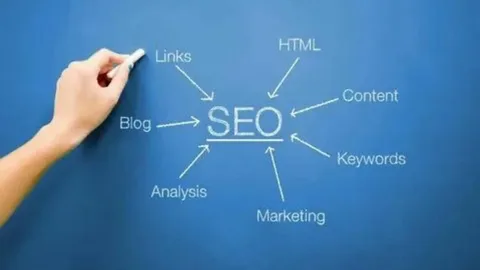In the ever-evolving landscape of digital marketing, one term has become increasingly prominent: Content Marketing. While traditional SEO (Search Engine Optimization) focuses on technical aspects like keywords and backlinks, content marketing emerges as a dynamic force that not only complements but also enhances the effectiveness of SEO strategies. This article explores the symbiotic relationship between content marketing and SEO, unraveling the power they hold when harnessed together.
Creating Value for Users
At the core of content marketing’s synergy with SEO is the emphasis on quality content. Search engines, particularly Google, prioritize delivering valuable and relevant content to users. By creating content that addresses user queries, solves problems, or provides valuable information, businesses can establish authority in their niche, leading to improved search engine rankings.
Meeting User Intent
Content marketing aligns with the concept of user intent. Understanding what users are searching for and tailoring content to meet those needs is crucial. Whether it’s informational, transactional, or navigational intent, well-crafted content ensures that a website not only attracts visitors but also retains them, signaling to search engines the relevance and utility of the content.
Strategic Keyword Integration
Keywords have long been a focal point in traditional SEO. Content marketing takes this a step further by seamlessly integrating strategically chosen keywords within high-quality content. Rather than keyword stuffing, which can lead to penalties, content marketing ensures that keywords are naturally woven into the narrative, enhancing the user experience and signaling relevance to search engines.
Embracing Semantic SEO
Content marketing embraces semantic SEO, an approach that goes beyond individual keywords to understand the context and meaning behind words. Search engines increasingly prioritize semantic relevance, recognizing the relationships between words and phrases. Well-structured, comprehensive content that covers a topic in-depth aligns with semantic SEO principles, signaling to search engines a thorough exploration of a subject.
Earning High-Quality Backlinks
Backlinks, or links from other websites to yours, remain a critical factor in SEO. Content marketing serves as a potent tool for earning high-quality backlinks naturally. When businesses produce valuable, shareable content, other websites are more likely to link to it as a resource. This organic backlink acquisition not only boosts SEO but also enhances the website’s authority and credibility.
Content as Linkable Assets
Certain types of content, such as research studies, infographics, and comprehensive guides, serve as linkable assets. These assets become go-to resources in their respective niches, attracting backlinks over time. Content marketing strategies that prioritize the creation of linkable assets contribute to the website’s backlink profile, a significant factor in search engine rankings.
Reducing Bounce Rates
User experience is a crucial factor in SEO, and content marketing plays a pivotal role in enhancing it. Engaging, informative content reduces bounce rates—the percentage of visitors who leave a site after viewing only one page. When visitors find valuable content that answers their queries, they are more likely to explore further, signaling to search engines that the website satisfies user intent.
Improving Dwell Time
Dwell time, the amount of time a user spends on a website, is another user experience metric considered by search engines. Compelling content that captivates and holds the audience’s attention contributes to longer dwell times. Whether it’s through engaging storytelling, multimedia elements, or interactive features, content marketing elevates the overall user experience.
Content Shareability on Social Media
Content marketing and social media go hand in hand. When businesses create shareable content, it amplifies their reach through social media platforms. Social signals, such as likes, shares, and comments, contribute to a website’s authority. Search engines recognize content that resonates on social media as relevant and valuable, influencing rankings.
Social Media as a Content Distribution Channel
Content marketing leverages social media as a distribution channel. Through strategic sharing on platforms like Facebook, Twitter, and LinkedIn, businesses can extend the reach of their content to a broader audience. This amplification not only drives traffic but also exposes the content to potential influencers and amplifiers in the industry.
Addressing Niche Queries
Content marketing enables businesses to target long-tail keywords—more specific, less competitive phrases that often reflect niche queries. By creating content that caters to these specific queries, businesses can capture highly targeted audiences. Long-tail keyword optimization aligns with the principles of content marketing, where depth and relevance matter more than sheer volume.
Expanding Content Depth and Breadth
Long-form content, such as comprehensive guides and in-depth articles, allows businesses to cover topics comprehensively. This approach not only addresses long-tail queries but also signals expertise and authority to search engines. Content marketing strategies that prioritize both depth and breadth contribute to a holistic SEO strategy.
Responsive and Mobile-Friendly Content
Content marketing recognizes the significance of mobile optimization. As more users access the internet through mobile devices, search engines prioritize mobile-friendly websites. Content that is responsive, loads quickly on mobile devices, and provides a seamless user experience contributes to improved rankings in mobile search results.
Structured Content for Featured Snippets
Structured content that answers specific queries in a concise format is more likely to be featured in snippet results. Featured snippets are highly visible on search engine results pages (SERPs), and content marketing strategies that aim for snippet inclusion enhance a website’s visibility and attract more clicks.
Staying Resilient to Algorithm Updates
Search engine algorithms undergo regular updates, and content marketing strategies offer adaptability. By focusing on creating high-quality, relevant content, businesses can weather algorithm changes. While specific SEO tactics may fluctuate in effectiveness, content marketing principles remain resilient, providing a stable foundation for sustainable SEO efforts.
Diversifying Content Formats
Diversifying content formats is another strategy for adaptability. From blog posts and articles to videos, infographics, and podcasts, content marketing embraces versatility. This diversification not only caters to different audience preferences but also aligns with the evolving ways in which search engines evaluate and present content.
Conclusion
In the intricate dance of digital marketing, content marketing and SEO move in tandem, creating a harmonious synergy that elevates a website’s visibility, authority, and user experience. As search engines evolve and user expectations shift, the power of content marketing in SEO becomes increasingly evident. By crafting valuable, relevant content that resonates with audiences and aligns with search engine algorithms, businesses can harness the full potential of this dynamic duo, propelling their online presence to new heights.


